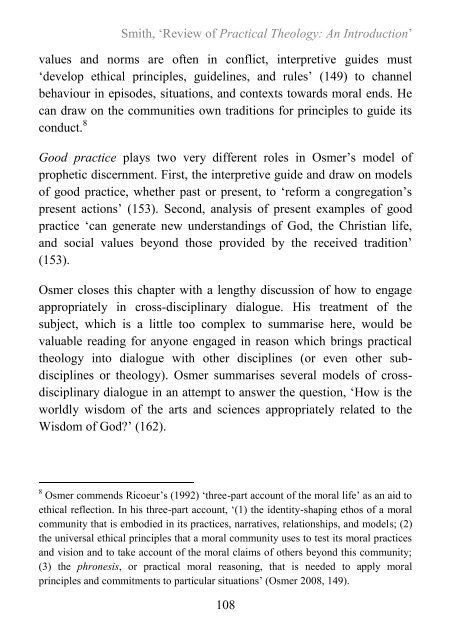Conspectus, vol. 10.pdf - South African Theological Seminary
Conspectus, vol. 10.pdf - South African Theological Seminary
Conspectus, vol. 10.pdf - South African Theological Seminary
You also want an ePaper? Increase the reach of your titles
YUMPU automatically turns print PDFs into web optimized ePapers that Google loves.
Smith, ‘Review of Practical Theology: An Introduction’<br />
values and norms are often in conflict, interpretive guides must<br />
‘develop ethical principles, guidelines, and rules’ (149) to channel<br />
behaviour in episodes, situations, and contexts towards moral ends. He<br />
can draw on the communities own traditions for principles to guide its<br />
conduct. 8<br />
Good practice plays two very different roles in Osmer’s model of<br />
prophetic discernment. First, the interpretive guide and draw on models<br />
of good practice, whether past or present, to ‘reform a congregation’s<br />
present actions’ (153). Second, analysis of present examples of good<br />
practice ‘can generate new understandings of God, the Christian life,<br />
and social values beyond those provided by the received tradition’<br />
(153).<br />
Osmer closes this chapter with a lengthy discussion of how to engage<br />
appropriately in cross-disciplinary dialogue. His treatment of the<br />
subject, which is a little too complex to summarise here, would be<br />
valuable reading for anyone engaged in reason which brings practical<br />
theology into dialogue with other disciplines (or even other subdisciplines<br />
or theology). Osmer summarises several models of crossdisciplinary<br />
dialogue in an attempt to answer the question, ‘How is the<br />
worldly wisdom of the arts and sciences appropriately related to the<br />
Wisdom of God’ (162).<br />
8 Osmer commends Ricoeur’s (1992) ‘three-part account of the moral life’ as an aid to<br />
ethical reflection. In his three-part account, ‘(1) the identity-shaping ethos of a moral<br />
community that is embodied in its practices, narratives, relationships, and models; (2)<br />
the universal ethical principles that a moral community uses to test its moral practices<br />
and vision and to take account of the moral claims of others beyond this community;<br />
(3) the phronesis, or practical moral reasoning, that is needed to apply moral<br />
principles and commitments to particular situations’ (Osmer 2008, 149).<br />
108

















